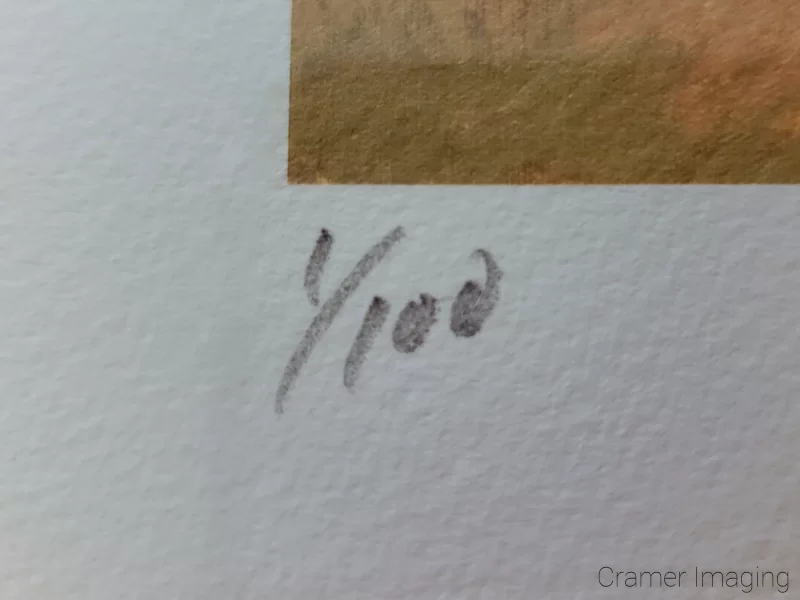If you’ve been around for a few years, you might have heard the term “limited-edition print” attached to artwork. Perhaps you’ve seen some art fitting that description or grew up in a household owning some. Maybe you own some yourself. Have you ever wondered about what limited-edition prints are and why we consider them as so special? If you have, you’re in luck because that’s what we’re discussing today.
What is a Limited-Edition Print?
A limited edition print is simply a print of a particular size (dimensions) which the artist or photographer has decided to only offer a certain amount of and that’s it. Let’s give an example to further solidify and illustrate this concept.
I’m a landscape photographer. I have a portfolio of several different landscape photos for sale. If I wanted to, I could choose one of my photos and say “I will only offer 100 of this photo at 16×24 inches. Then I won’t make any more ever.” Back in the days of film, this often meant destroying the negative so you literally couldn’t make any more.
One-of-a-Kinds are technically limited editions of one. However, the art market does not currently recognize them as such.
What Makes a Limited-Edition Print Special?
What makes a limited-edition print special is artificial scarcity. By saying that there is a set amount and will only ever be a set amount available, the artist/photographer is keeping the supply low. They do this in hopes of increasing the demand and, thereby, the price attached to each printout of the series. In simple terms, this means that I (as an artist/photographer) say “Because I’m only EVER making this many, I can charge you more if you want one of these prints.”

How to Identify a Limited-Edition Print
Limited-edition prints often display easily identifiable marks to show that they are indeed limited editions. Artists/photographers often sign limited-edition prints; however, this is not a requirement. The photographer/artist may choose to use either or both options to identify the print as limited edition.
Option 1
You will find the print itself often marked in the corner with the number of the print over the total number of prints in the series. Check out this example.

Option 2
The print will come with a certificate of authenticity. This certificate specifically mentions that the attached print is limited edition. It also displays the same identifying marks of which print number you have and how many prints total are in the series.

How Do Limited-Edition Prints Work in the Art Market?
This is a very good question to ask. Due to the artificial scarcity created by the artist/photographer, the art market tends to treat limited-edition prints a bit differently than other pieces of art. However, this only applies in certain cases as we will discuss.
The art market considers another point about limited editions. It seems that the lower the number of the print in the series, the more valuable the market considers that print. It feels arbitrary, but that’s how the art market works.

Artist Reputation
Limited editions only work well if you are the kind of artist who has a well-known reputation. If you are a nobody as an artist, then limited editions will mean practically nothing to you. They will also mean nothing to the art market as most of your value as an artist is determined by your reputation.

Possessing a limited edition from an artist/photographer of big reputation can net you a lot of money when you sell. A limited edition by an artist/photographer of little to no reputation will not be worth much should you try to sell it. Oftentimes, such art ends up donated to second-hand stores when no longer wanted.
Tainted Market
The idea behind a limited-edition print series is that you make that print in that size only a certain number of times and then that’s it. You make no more in that size ever. The problem is that some artists and photographers have come to taint the market of their limited editions. They do so by recreating the print(s) in a slightly different size and making it a different limited-edition series.

Imagine if I, as a landscape photographer, decided that I was going to create a 100 print limited edition series of one of my photos in 16×24 inches. Then I decided to make another in 15.5×24 inches then another in 16×23.5 inches. I’ve deceived you into thinking that there were only 100 prints when there were really 300 of very close and similar sizes. This is market pollution, and it taints and degrades the limited-edition art market for all.
Conclusion
Limited-edition prints are a construct created to manipulate the art market into valuing a particular piece of art more than it would otherwise. If the reputed artist/photographer doesn’t taint the market, then limited editions can bring in a pretty penny for said artist/photographer. The art market places higher value on the art knowing that there will only EVER be a certain amount of those sized prints made.
The ironic thing is that, oftentimes, open edition prints often don’t have as many prints in the series as limited editions do. But, due to the open-ended nature of the series, you will never know exactly how many prints are out there. This is why limited edition print series receive a much more preferred status in the art market. This is what makes limited-edition prints so special.




